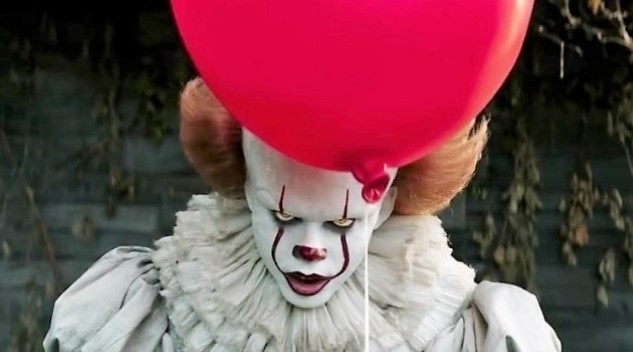Cultural classic revives horror genre with childhood boogeyman
Sep 28, 2017
After 31 years of terrifying people from bookshelves across America, Stephen King’s infamous ‘It’ reached a new level of terror when it opened in theaters Sept. 8.
Director Andy Muschietti was able to take a nightmarish and gruesome tale and turn it into a coming-of-age story about bonds, friendship and conquering fear.
The movie is set in the summer of 1989, in the small town of Derry, Maine, as seven children come together when they discover they have something in common.
Besides being portrayed as losers and outcasts, they stumble upon an ancient evil that has plagued their quiet town for decades.
It, the terrifying clown that serves as the film’s antagonist, is a being that turns the children’s worst nightmares into reality, forcing them to realize that in unity they’re stronger than even their most hellish fears.
It is an evil that adults don’t tend to notice even when children go missing day after day.
Although some elements of King’s novel (from 1986) are not included, for good reason I might add, “It” is an astonishing read.
With moments that make you jump and leave many whimpering, as the movie draws on, more suspenseful events continue to unravel.
The film almost makes it impossible to see a red balloon without triggering some deep-rooted fear for a week.
Swedish actor Bill Skarsgard’s portrayal of It, or Pennywise the dancing clown, is original and is in its own creative category compared to Tim Curry’s rendition of the antagonist.
With an R-rating, this cast was able to dive deeper into the horror than the two-part mini series broadcasted on ABC television network 27 years ago.
Coincidentally, the release of this movie aligns right on time with the clown’s feeding cycle.
The childhood cast stepped up to the challenge of playing the ragtag group of Losers.
Actor Jaeden Lieberher plays the main protagonist, Bill, the older brother who is determined to find out what happened to his missing younger brother Georgie.
If you remember, Georgie got his arm chomped off by It and was dragged into the drain.
Bill’s ability to lead the Loser’s Club was the reason they decide to rally in the end to vanquish the killer clown, simultaneously vanquishing their deepest fears.
The only girl in the Loser’s Club, Sophia Lillis’ Beverly Marsh, is tough and unfazed by public opinion of her. She is unapologetic when it comes to reigning justice on the bullies when they harass Mike, the new kid on the block.
The character in the movie who won viewers over had to be Finn Wolfhard’s portrayal of Richie, originally played by child star Seth Green in one of his earlier roles.
Richie is vulgar, a true troll of the 80’s, with perfectly timed mama and virgin jokes.
Actor Jack Dylan Grazer’s version of the placebo popping Eddie in 2017 measured well against the portrayal of the character in the 80’s film.
The matching fanny pack, where he keeps his medication coupled with his mentions of grey water every time they go down to the sewers was a call back to the earlier script.
Eddie’s hypochondriac-like behavior is caused by his overbearing mother who pushes him to believe that he’s one missed-inhaler breath away from a bubble.
Stephen King’s original story sets the bar high with his 1,100 plus page turner.
King’s original inspiration for “It” came from the children’s story, Three Billy Goats Gruff, stating that Pennywise started out as a troll instead of a clown it the sewers.
Interweaving the theme of kids and the adults they later become, the novel phases between two timelines.
One in which the children of Derry grow up and forget all about that summer long ago and the oath they took to come back if It were to ever return.
In the book, the fear became most apparent when Bill regains his childhood stutter after a call from Mike Hanlon, his old friend from Derry, who helped him defeat It.
Derry also happens to be the last member of the Losers still living in the town.
No adult in this film could see the writing on the walls, or the blood exploding out of the drains.
In defense of the parents, who of course were children at one point, their blockage meant they endured the horrors of the dancing clown in their youth as well.
Anyone who experienced such tragedy as a child can be expected to grow up and become detached if It were to return to this realm.
In the book, Pennywise says he doesn’t prey on adults because it’s harder to manipulate their fears.
When Bill builds a diagram of the sewer system, to find his missing brother, his father screams at him in rage to protect his mother’s feelings.
Rather than comfort Bill in his grieving for Georgie, his father, tells him his brother is gone and he’s not coming back.
It was almost as if the parents of Derry tried to forget what happened to them and not get roped back into the madness, even at the expense of losing their other children.
When the Loser’s Club grew up, they dealt with their pain and fears in similar ways.
The oath they made to each other stands tall to bring them back into the fold of Derry if It ever returns to terrorize other children.
A reoccurring theme to both film adaptations and the novel is the element of water.
Throughout the novel it is mentioned numerous times.
The first time Pennywise makes his appearance in the film is on a stormy day when he appears to Georgie.
He’s reintroduced to the loser’s in adulthood, after a young girl is found dead in the middle of a similar storm 27 years later.
Using the sewer as its lair, many of the clown’s encounters with children is centered around some form of water.
The children’s inability to control their fear is parallel to their lack of control over water.
It can be contained but not destroyed, and after it is contained it just keeps coming back. Just like Pennywise.
The conversation between Pennywise and Georgie set the foundation of the floating theme.
Georgie asks Pennywise if the balloons promised to him could float. The clown laughs sinisterly and answers that they do float and when he comes down there with him he will float too.
When It reveals his true form to his victims, the site of him puts them into a catatonic state.
They remain in his lair, in the coma-like state, until they are devoured.
Floating is looked at as a type of purgatory for the lost children who are suspended in air.
The decision to split the original story into two films is important when telling the full story rather than missing key elements important to the story.
Fans of the novel will be proud of this film.



